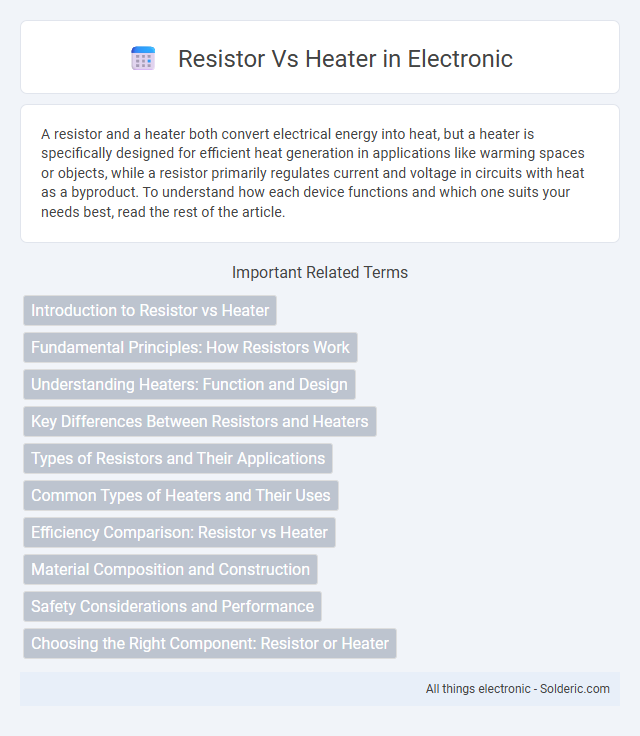A resistor and a heater both convert electrical energy into heat, but a heater is specifically designed for efficient heat generation in applications like warming spaces or objects, while a resistor primarily regulates current and voltage in circuits with heat as a byproduct. To understand how each device functions and which one suits your needs best, read the rest of the article.
Comparison Table
| Feature | Resistor | Heater |
|---|---|---|
| Purpose | Limit or regulate electrical current | Convert electrical energy to heat |
| Primary Function | Control voltage and current in circuits | Generate heat for warming or thermal processes |
| Material | Carbon, metal film, or wire-wound | Nickel-chromium alloys, ceramic, or metal elements |
| Power Rating | Fraction of a watt to several watts | Hundreds to thousands of watts |
| Heat Generation | Minimal, usually undesired | Primary function, efficient heat output |
| Application | Electrical circuits, signal conditioning | Space heating, industrial processing, appliances |
| Design | Compact, designed for stable resistance | Robust, designed for sustained heat emission |
Introduction to Resistor vs Heater
Resistors control electrical current by converting energy into heat through electrical resistance, commonly used in circuits to manage voltage and current flow. Heaters, specifically designed to generate heat, utilize resistive elements to convert electrical energy into thermal energy for temperature regulation in appliances and industrial applications. The main difference lies in their primary function: resistors focus on electrical regulation, while heaters prioritize efficient heat production.
Fundamental Principles: How Resistors Work
Resistors operate based on the principle of electrical resistance, where they limit the flow of electric current by converting electrical energy into heat due to collisions between electrons and the atomic structure of the resistor material. This controlled resistance follows Ohm's Law, establishing a predictable voltage drop proportional to the current. In contrast, heaters exploit resistance to generate heat intentionally, using materials designed for high resistivity to convert electrical energy efficiently into thermal energy for heating applications.
Understanding Heaters: Function and Design
Heaters convert electrical energy into heat through resistive elements designed to withstand high temperatures and ensure efficient thermal transfer. Unlike standard resistors primarily used to control current, heater elements prioritize durability and consistent heat output in various applications such as space heating and industrial processes. Their design often incorporates materials like nichrome wire or ceramic substrates to optimize performance and longevity under thermal stress.
Key Differences Between Resistors and Heaters
Resistors primarily control electrical current and voltage in circuits by providing precise resistance measured in ohms, while heaters convert electrical energy into heat for warming applications, often rated by wattage. Resistors are designed for stable, predictable resistance to manage current flow, whereas heaters focus on maximum heat dissipation and thermal efficiency. Materials used in resistors, such as carbon or metal film, differ from heater elements like nichrome or ceramic, optimized for sustained high-temperature operation.
Types of Resistors and Their Applications
Wirewound resistors, known for their high power dissipation and precise resistance values, are commonly used in heating elements where controlled heat generation is essential. Film resistors, including metal oxide and carbon film types, offer stability and accuracy, making them suitable for electronic circuits rather than direct heating applications. Your choice between resistors and heaters depends on whether you need precise electrical resistance for circuit regulation or consistent thermal output for temperature control.
Common Types of Heaters and Their Uses
Common types of heaters include resistance heaters, ceramic heaters, and infrared heaters, each serving distinct applications. Resistance heaters use resistive materials to convert electrical energy into heat, ideal for space heating and industrial processes requiring precise temperature control. Infrared heaters emit radiant heat for targeted warming, commonly used in outdoor heating and therapeutic devices, while ceramic heaters offer efficient convection heating suited for indoor environments.
Efficiency Comparison: Resistor vs Heater
Resistors convert electrical energy into heat with nearly 100% efficiency, as virtually all electrical power dissipates as thermal energy. Heaters, designed specifically for heating applications, optimize heat distribution and retention, sometimes incorporating materials or mechanisms to improve energy transfer to the surrounding environment. While both rely on Joule heating principles, specialized heaters typically achieve better overall system efficiency by minimizing heat loss and targeting heat output more effectively than basic resistors.
Material Composition and Construction
Resistors are typically made from carbon film, metal oxide, or wire-wound materials designed to provide precise resistance values and stability under electrical stress. Heaters utilize materials such as nichrome or other high-resistance alloys capable of withstanding high temperatures while efficiently converting electrical energy into heat. The construction of resistors often involves encapsulation for protection and minimal heat dissipation, whereas heaters are built with exposed or insulated elements optimized for maximum thermal output.
Safety Considerations and Performance
Resistors and heaters differ significantly in safety and performance; resistors are designed to limit current with minimal heat generation, while heaters convert electrical energy into heat intentionally and require robust temperature control to prevent overheating and fire hazards. Your choice should account for the resistor's power rating and thermal dissipation capacity versus the heater's insulation, thermal efficiency, and built-in safety features such as thermostats or thermal cutoffs. Proper application ensures optimal performance, with resistors offering precise electrical control and heaters providing reliable heat output under regulated conditions.
Choosing the Right Component: Resistor or Heater
Selecting the right component between a resistor and a heater depends on the application's power dissipation and thermal requirements. Resistors primarily limit current and dissipate small amounts of heat in electronic circuits, while heaters are designed to convert electrical energy into significant thermal energy for space heating or industrial processes. Understanding the required heat output, resistance value, power rating, and ambient conditions ensures optimal performance and safety in the final design.
resistor vs heater Infographic

 solderic.com
solderic.com